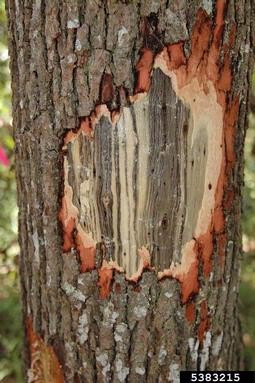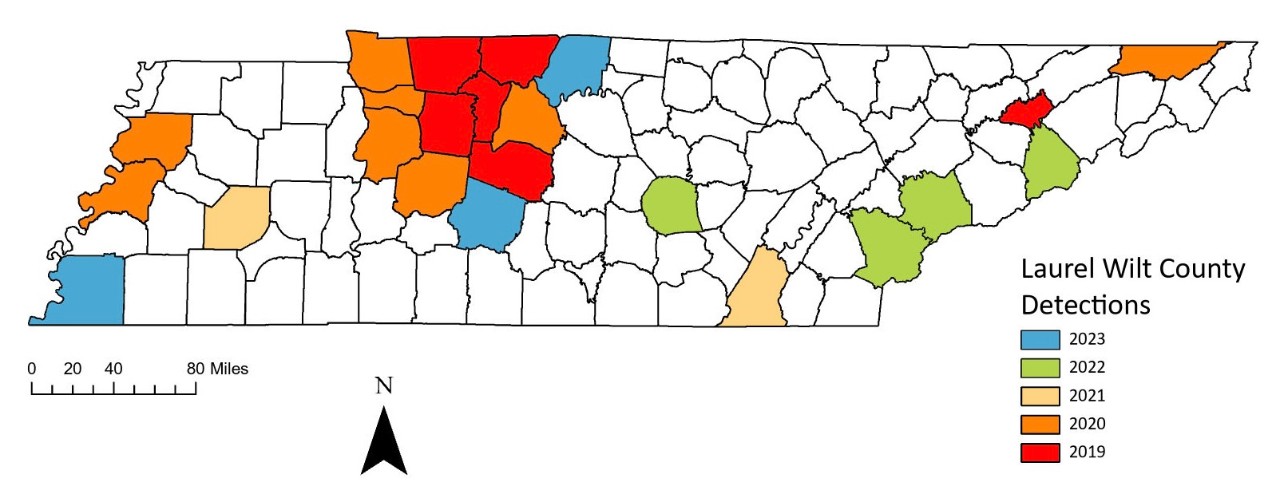Laurel Wilt
Introduction
First discovered in 2002, laurel wilt has rapidly become a disease of serious concern in the southeastern U.S. The fungus which causes laurel wilt (Harringtonia lauricola) can kill mature trees very quickly. The fungus has been shown to be vectored by a small ambrosia beetle from Asia, the redbay ambrosia beetle (Xyleborus glabratus), although several other species of insects can vector the fungus as well. It affects plants of the Lauraceae family, most commonly redbay in coastal areas where the disease was first discovered; in Tennessee, it impacts sassafras and spicebush. The disease has become a serious concern because of its ecological impacts on redbay groves along the coast, and its potential economic impact on avocado (an important crop in Florida), which is also susceptible. Laurel wilt was detected in Tennessee in 2019 on sassafras and has since spread to 23 counties.
Identification
Symptoms of the disease may be similar to drought. Sassafras and spicebush leaves may rapidly wilt or turn bright red or orange, as if for autumn, during the summer; this premature color is often followed by leaves turning reddish-brown and drooping. Leaves are often retained on the tree well after typical leaf drop in the fall. Symptoms may start in an isolated branch or in the top of the tree or shrub but will spread throughout the entire plant rapidly. Most trees wilt and die a few weeks or months after symptoms first appear.
Discoloration in the outer sapwood is clearly visible in dead or dying trees. Staining will be dark purplish or black; vascular discoloration can be seen by looking at wilted branches in cross section or removing the bark to expose the xylem. Staining in dead trees extends through the roots, stem, and all branches.
Redbay ambrosia beetles are very difficult to detect, especially prior to the tree’s death. Small round entrance holes (less than 1/32 inch diameter) may be visible on the stems and branches of severely wilted or dead trees. Toothpick-like tubes of sawdust may be expelled from beetle galleries and stick out of dead trees; sawdust tubes are easily destroyed by wind or washed away by rain. Sawdust may be visible at the base of the tree. The beetle is 1/16 inch long, dark brown or black, and shiny. There are several species of ambrosia beetles (native and exotic) as well as other types of insects which attack Lauraceae plants and can vector the fungus as well. The fungus can also be spread from root grafts where susceptible plants grow together in close proximity, so stands of sassafras may be infected from neighboring infected trees.
Once introduced into the tree’s vascular system, the fungus rapidly spreads in the sapwood throughout the entire tree. The tree responds by plugging its vascular system to prevent spread of the fungus, but this limits water movement in the sapwood. Therefore, trees wilt and die rapidly after infection, causing the typical symptoms of wilting leaves and discoloration under the bark. These symptoms are exhibited after the tree has been infected and is too late to be treated.
Current Situation
Since its detection in Tennessee in 2019, laurel wilt has spread to 23 counties as of 2023. The Laurel Wilt Dashboard shows an up to date map of counties confirmed to have laurel wilt across the southeastern U.S.
Laurel wilt has been detected on sassafras (Sassafras albidum) and spicebush (Lindera benzoin). Redbay ambrosia beetles have been detected in Tennessee, but many other vectors are also likely attributable to the extent of the disease across the state.
Several counties where detections have been made are in distinct areas, not contiguous with other confirmed counties. This may be due in part to multiple introductions of the disease to parts of Tennessee or to human transport of infected material.
Management
There are limited options for preventing laurel wilt disease in sassafras. One fungicide labeled for use in sassafras is propiconazole, which must be administered as a root-flare or trunk injection by a certified pesticide applicator. These treatments have only demonstrated effectiveness at protecting the tree prior to infection; once a tree is infected, treatments are no longer effective.
With the cost of treatment being high, in many situations it is not economically feasible to continually treat sassafras over the long-term, and often it may be more feasible to remove hazardous trees after they have died. However, continued research is also being conducted on other systemic insecticides and fungicides and other methods of treatment which might be more feasible for large-scale treatment or continual retreatments of high-value sassafras.
Human movement of infested wood is responsible for the disease’s rapid spread through the southeast. Limiting the movement of wood material and inspecting that material to prevent accidental spread of this disease is important. If laurel wilt is suspected in counties not yet confirmed to have laurel wilt, contact the Tennessee Division of Forestry.
What Can You Do?
There is no cure once a tree has this disease. Preventing the spread of this disease by not transporting firewood or other untreated wood material is of the utmost importance, as management options are limited.


